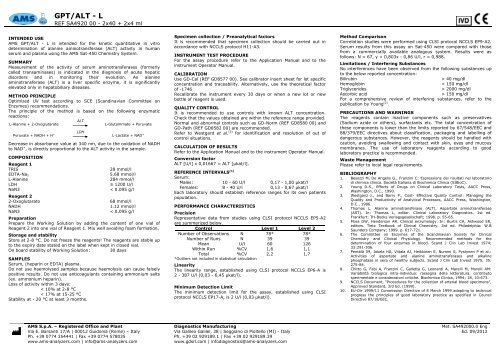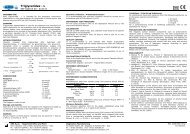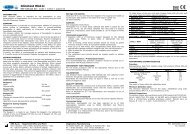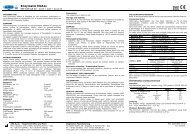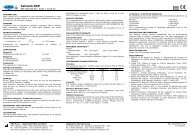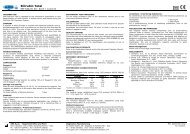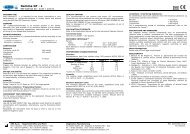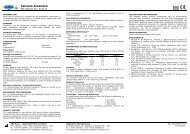GPT/ALT - L - Gdsrl.com
GPT/ALT - L - Gdsrl.com
GPT/ALT - L - Gdsrl.com
You also want an ePaper? Increase the reach of your titles
YUMPU automatically turns print PDFs into web optimized ePapers that Google loves.
<strong>GPT</strong>/<strong>ALT</strong> - L<br />
REF SA4920 00 - 2x40 + 2x4 ml<br />
INTENDED USE<br />
AMS <strong>GPT</strong>/<strong>ALT</strong> - L is intended for the kinetic quantitative in vitro<br />
determination of alanine aminotransferase (<strong>ALT</strong>) activity in human<br />
serum and plasma using the AMS Sat-450 Chemistry System.<br />
SUMMARY<br />
Measurement of the activity of serum aminotransferases (formerly<br />
called transaminases) is indicated in the diagnosis of acute hepatic<br />
disorders and in monitoring their evolution. As alanine<br />
aminotransferase (<strong>ALT</strong>) is a liver specific enzyme, it is significantly<br />
elevated only in hepatobiliary diseases.<br />
METHOD PRINCIPLE<br />
Optimized UV test according to SCE (Scandinavian Committee on<br />
Enzymes) re<strong>com</strong>mendations.<br />
The principle of the method is based on the following enzymatic<br />
reactions:<br />
<strong>ALT</strong><br />
L-Alanine + 2-Oxoglutarate<br />
L-Glutammate + Pyruvate<br />
Pyruvate + NADH + H +<br />
LDH<br />
L-Lactate + NAD +<br />
Decrease in absorbance value at 340 nm, due to the oxidation of NADH<br />
to NAD + , is directly proportional to the <strong>ALT</strong> activity in the sample.<br />
COMPOSITION<br />
Reagent 1<br />
TRIS 28 mmol/l<br />
EDTA-Na2<br />
5.68 mmol/l<br />
L-Alanine 284 mmol/l<br />
LDH ≥ 1200 U/l<br />
NaN3 < 0.095 g/l<br />
Reagent 2<br />
2-Oxoglutarato 68 mmol/l<br />
NADH 1.12 mmol/l<br />
NaN3 < 0.095 g/l<br />
Preparation<br />
Prepare the Working Solution by adding the content of one vial of<br />
Reagent 2 into one vial of Reagent 1. Mix well avoiding foam formation.<br />
Storage and stability<br />
Store at 2-8 °C. Do not freeze the reagents! The reagents are stable up<br />
to the expiry date stated on the label when kept in closed vial.<br />
On board stability of Working Solution: 30 days<br />
SAMPLES<br />
Serum, (heparin or EDTA) plasma.<br />
Do not use haemolysed samples because haemolysis can cause falsely<br />
positive results. Do not use anticoagulants containing ammonium salts<br />
(ex. ammonium heparin).<br />
Loss of activity within 3 days:<br />
< 10% at 2-8 °C<br />
< 17% at 15-25 °C<br />
Stability at - 20 °C at least 3 months.<br />
Specimen collection / Preanalytical factors<br />
It is re<strong>com</strong>mended that specimen collection should be carried out in<br />
accordance with NCCLS protocol H11-A3.<br />
INSTRUMENT TEST PROCEDURE<br />
For the assay procedure refer to the Application Manual and to the<br />
instrument Operator Manual.<br />
CALIBRATION<br />
Use GD-Cal (REF GD8577 00). See calibrator insert sheet for lot specific<br />
concentration and traceability. Alternatively, use the theoretical factor<br />
of -1746<br />
Recalibrate the instrument every 30 days or when a new lot or new<br />
bottle of reagent is used.<br />
QUALITY CONTROL<br />
It is re<strong>com</strong>mended to use controls with known <strong>ALT</strong> concentration.<br />
Check that the values obtained are within the reference range provided.<br />
Normal and abnormal controls such as GD-Norm (REF GD8580 00) and<br />
GD-Path (REF GD8582 00) are re<strong>com</strong>mended.<br />
Refer to Westgard et al. (3) for identification and resolution of out of<br />
control situations.<br />
CALCULATION OF RESULTS<br />
Refer to the Application Manual and to the instrument Operator Manual.<br />
Conversion factor<br />
<strong>ALT</strong> [U/l] x 0,01667 = <strong>ALT</strong> [µkat/l].<br />
REFERENCE INTERVALS (1)<br />
Serum:<br />
Males: 10 - 60 U/l 0,17 - 1,00 µkat/l<br />
Females: 8 - 40 U/l 0,13 - 0,67 µkat/l<br />
Each laboratory should establish reference ranges for its own patients<br />
population.<br />
PERFORMANCE CHARACTERISTICS<br />
Precision<br />
Representative data from studies using CLSI protocol NCCLS EP5-A2<br />
are summarized below.<br />
Control Level 1 Level 2<br />
Number of Observations N 78* 78*<br />
Number of Runs N 39 39<br />
Mean U/l 60 126<br />
Within Run %CV 1,6 1,1<br />
Total %CV 2,2 1,7<br />
*Outliers not included in statistical calculation<br />
Linearity<br />
The linearity range, established using CLSI protocol NCCLS EP6-A is<br />
2 - 387 U/l (0,03 - 6,45 µkat/l).<br />
Minimum Detection Limit<br />
The minimum detection limit for the assay, established using CLSI<br />
protocol NCCLS EP17-A, is 2 U/l (0,03 µkat/l).<br />
AMS S.p.A. – Registered Office and Plant Diagnostics Manufacturing<br />
Via E. Barsanti 17/A | 00012 Guidonia (Rome) – Italy Via Galileo Galilei, 38 | Seggiano di Pioltello (MI) - Italy<br />
Ph. +39 0774 354441 | Fax +39 0774 578035 Ph. +39 02 929189.1 | Fax +39 02 929189.39<br />
www.ams-analyzers.<strong>com</strong> | info@ams-analyzers.<strong>com</strong> www.gdsrl.<strong>com</strong> | infodiagnostics@ams-analyzers.<strong>com</strong><br />
Method Comparison<br />
Correlation studies were performed using CLSI protocol NCCLS EP9-A2.<br />
Serum results from this assay on Sat-450 were <strong>com</strong>pared with those<br />
from a <strong>com</strong>mercially available analogous system. Results were as<br />
follows: N = 67, y = 0,803x - 0,86 U/l, r = 0,988.<br />
Limitations / Interfering Substances<br />
No interferences have been observed from the following substances up<br />
to the below reported concentration:<br />
Bilirubin > 40 mg/dl<br />
Hemoglobin > 150 mg/dl<br />
Triglycerides > 2000 mg/dl<br />
Ascorbic acid > 150 mg/dl<br />
For a <strong>com</strong>prehensive review of interfering substances, refer to the<br />
publication by Young (2) .<br />
PRECAUTIONS AND WARNINGS<br />
The reagents contain inactive <strong>com</strong>ponents such as preservatives<br />
(Sodium azide or others), surfactants etc. The total concentration of<br />
these <strong>com</strong>ponents is lower than the limits reported by 67/548/EEC and<br />
88/379/EEC directives about classification, packaging and labelling of<br />
dangerous substances. However, the reagents should be handled with<br />
caution, avoiding swallowing and contact with skin, eyes and mucous<br />
membranes. The use of laboratory reagents according to good<br />
laboratory practice is re<strong>com</strong>mended.<br />
Waste Management<br />
Please refer to local legal requirements.<br />
BIBLIOGRAPHY<br />
1. Besozzi M, De Angelis G., Franzini C: Espressione dei risultati nel laboratorio<br />
di chimica clinica. Società Italiana di Biochimica Clinica (SIBioC).<br />
2. Young D.S., Effects of Drugs on Clinical Laboratory Tests, AACC Press,<br />
Washington, D.C., 1990.<br />
3. Westgard J., and Barry P., Cost- Effective Quality Control: Managing the<br />
Quality and Productivity of Analytical Processes, AACC Press, Washington,<br />
D.C., 1986.<br />
4. Thomas L. Alanine aminotransferase (<strong>ALT</strong>), Aspartate aminotransferase<br />
(AST). In: Thomas L, editor. Clinical Laboratory Diagnostics. 1st ed.<br />
Frankfurt: TH-Books Verlagsgesellschaft; 1998. p. 55-65.<br />
5. Moss DW, Henderson AR. Clinical enzymology. In: Burtis CA, Ashwood ER,<br />
editors. Tietz Textbook of Clinical Chemistry. 3rd ed. Philadelphia: W.B<br />
Saunders Company; 1999. p. 617-721.<br />
6. The Committee on Enzymes of the Scandinavian Society for Clinical<br />
Chemistry and Clinical Physiology. Re<strong>com</strong>mended methods for the<br />
determination of four enzymes in blood. Scand J Clin Lab Invest 1974;<br />
33:291-306.<br />
7. Penttilä IM, Jokela HA, Viitala AJ, Heikkinen E, Nummi S, Pystynen P et al.:<br />
Activities of aspartate and alanine aminotransferases and alkaline<br />
phosphatase in sera of healthy subjects. Scand J Clin Lab Invest 1975; 35:<br />
275-84.<br />
8. Chitto G, Fabi A, Franzini C, Galletta G, Leonardi A, Marelli M, Morelli AM:<br />
Variabilità biologica intra-individuo: rassegna della letteratura, contributo<br />
sperimentale e considerazioni critiche. Biochimica Clinica, 1994; 18, 10:673.<br />
9. NCCLS Document, “Procedures for the collection of arterial blood specimens”,<br />
Approved Standard, 3rd Ed. (1999).<br />
10. EU-Dir 1999/11 Commission Directive of 8 March 1999 adapting to technical<br />
progress the principles of good laboratory practice as specified in Council<br />
Directive 87/18/EEC.<br />
Met. SA492000.0 Eng<br />
Ed. 09/2012
<strong>GPT</strong>/<strong>ALT</strong> - L<br />
REF SA4920 00 - 2x40 + 2x4 ml<br />
USO<br />
Il kit AMS <strong>GPT</strong>/<strong>ALT</strong> - L viene impiegato per la determinazione cinetica<br />
quantitativa in vitro dell’alanina aminotransferasi (<strong>ALT</strong>) nel siero e<br />
plasma umano con sistema AMS Sat-450.<br />
SOMMARIO<br />
La determinazione dell'attività delle aminotransferasi del siero<br />
(originariamente chiamate transaminasi) è indicata nella diagnosi di<br />
disturbi epatici acuti e nel monitoraggio della loro evoluzione. Poichè<br />
l'alanina aminotranferasi (<strong>ALT</strong>) è un enzima specifico del fegato, risulta<br />
elevato in modo significativo soltanto nelle malattie epatobiliari.<br />
PRINCIPIO<br />
Metodo UV ottimizzato secondo le rac<strong>com</strong>andazioni della SCE<br />
(Scandinavian Committee on Enzymes).<br />
Il metodo è basato sulle seguenti reazioni enzimatiche:<br />
L-Alanina + 2-<br />
Ossoglutarato<br />
Piruvato + NADH + H +<br />
<strong>ALT</strong><br />
LDH<br />
L-Glutammato + Piruvato<br />
L-Lattato + NAD +<br />
La diminuzione di assorbanza a 340 nm, dovuta all'ossidazione del<br />
NADH in NAD + , è direttamente proporzionale all'attività dell'<strong>ALT</strong> nel<br />
campione.<br />
COMPOSIZIONE<br />
Reagente 1<br />
TRIS 28 mmol/l<br />
EDTA-Na2<br />
5.68 mmol/l<br />
L-Alanina 284 mmol/l<br />
LDH ≥ 1200 U/l<br />
NaN3 < 0.095 g/l<br />
Reagente 2<br />
2-Ossoglutarato 68 mmol/l<br />
NADH 1.12 mmol/l<br />
NaN3 < 0.095 g/l<br />
Preparazione<br />
Preparare la Soluzione di Lavoro versando il contenuto di un flacone di<br />
Reagente 2 in un flacone di Reagente 1. Miscelare bene evitando la<br />
formazione di schiuma.<br />
Conservazione e Stabilità<br />
Conservare a 2-8 °C. Non congelare i reattivi! I reattivi sono stabili fino<br />
alla data di scadenza riportata in etichetta, se conservati in flacone<br />
chiuso.<br />
Stabilità a bordo dello strumento della Soluzione di Lavoro: 30 giorni<br />
CAMPIONI<br />
Siero, plasma (eparina o EDTA).<br />
Non usare campioni emolizzati poiché l'emolisi può causare risultati<br />
falsamente positivi. Anticoagulanti contenenti sale d’ammonio (ad es.<br />
ammonio eparina) non devono essere utilizzati.<br />
Perdita di attività entro 3 giorni:<br />
< 10% a 2-8 °C<br />
< 17% a 15-25 °C<br />
Stabilità a - 20 °C almeno 3 mesi.<br />
Raccolta dei Campioni / Fattori Preanalitici<br />
Si rac<strong>com</strong>anda di effettuare la raccolta dei campioni in conformità al<br />
Protocollo NCCLS H11-A3.<br />
PROCEDURA DI ANALISI<br />
Per la procedura di analisi fare riferimento all’Application Manual e al<br />
Manuale dell’Operatore dello strumento.<br />
CALIBRAZIONE<br />
Utilizzare GD-Cal (REF GD8577 00). Riferirsi all’inserto del calibratore<br />
per la concentrazione specifica del lotto e la tracciabilità.<br />
Alternativamente, utilizzare il fattore teorico di -1746.<br />
Ricalibrare lo strumento ogni 30 giorni o quando viene utilizzato un<br />
nuovo lotto o una nuova bottiglia di reagente.<br />
CONTROLLO DI QUALITA’<br />
Si rac<strong>com</strong>anda l’uso di controlli a titolo noto di <strong>ALT</strong>. Verificare che il<br />
valore ottenuto sia all’interno degli intervalli di accettabilità forniti. Si<br />
consiglia l’uso di controlli Normale e Patologico <strong>com</strong>e GD-Norm (REF<br />
GD8580 00) e GD-Path (REF GD8582 00).<br />
Far riferimento a Westgard et al. (3) per l’identificazione e la risoluzione<br />
di problematiche legate ai controlli fuori dai limiti.<br />
CALCOLO DEI RISULTATI<br />
Riferirsi all’Application Manual e al Manuale dell’Operatore dello<br />
strumento.<br />
Fattori di Conversione<br />
<strong>ALT</strong> [U/l] x 0,01667 = <strong>ALT</strong> [µkat/l].<br />
INTERVALLO DI RIFERIMENTO (1)<br />
Siero:<br />
Uomini: 10 - 60 U/l 0,17 - 1,00 µkat/l<br />
Donne: 8 - 40 U/l 0,13 - 0,67 µkat/l<br />
Si rac<strong>com</strong>anda ad ogni laboratorio di stabilire i propri valori normali in<br />
funzione della popolazione su cui opera.<br />
PRESTAZIONI ANALITICHE<br />
Precisione<br />
Dati rappresentativi dello studio secondo il protocollo CLSI NCCLS<br />
EP5-A2 sono sotto riportati.<br />
Controllo Livello 1 Livello 2<br />
Numero di Osservazioni N 78* 78*<br />
Numero di Prove N 39 39<br />
Media U/l 60 126<br />
Nella Corsa %CV 1,6 1,1<br />
Totale %CV 2,2 1,7<br />
*Valori fuori limite non inclusi nei calcoli statistici<br />
Linearità<br />
L’intervallo di linearità, stabilito tramite il protocollo CLSI NCCLS EP6-A<br />
è risultato pari a 2 - 387 U/l (0,03 - 6,45 µkat/l).<br />
Limite Minimo di Rivelabilità<br />
Il limite minimo di rilevabilità, stabilito tramite il protocollo CLSI NCCLS<br />
EP17-A, è 2 U/l (0,03 µkat/l).<br />
AMS S.p.A. – Sede Legale e Stabilimento Produzione Diagnostici<br />
Via E. Barsanti 17/A | 00012 Guidonia (Roma) – Italia Via Galileo Galilei, 38 | Seggiano di Pioltello (MI) - Italia<br />
Tel. +39 0774 354441 | Fax +39 0774 578035 Tel. +39 02 929189.1 | Fax +39 02 929189.39<br />
www.ams-analyzers.<strong>com</strong> | info@ams-analyzers.<strong>com</strong> www.gdsrl.<strong>com</strong> | infodiagnostics@ams-analyzers.<strong>com</strong><br />
Comparazione fra Metodi<br />
Studi di correlazione sono stati effettuati secondo il protocollo CLSI<br />
NCCLS EP9-A2. I risultati dei sieri di questo dosaggio su Sat-450 sono<br />
stati confrontati con un sistema analogo presente in <strong>com</strong>mercio. I<br />
risultati sono stati i seguenti: N = 67, y = 0,803x - 0,86 U/l, r = 0,988.<br />
Limitazioni / Sostanze Interferenti<br />
Nessuna interferenza è stata osservata dalle seguenti sostanze fino alla<br />
concentrazione sotto indicata:<br />
Bilirubina > 40 mg/dl<br />
Emoglobina > 150 mg/dl<br />
Trigliceridi > 2000 mg/dl<br />
Acido Ascorbico > 150 mg/dl<br />
Per una panoramica <strong>com</strong>pleta sulle sostanze interferenti si rimanda alla<br />
pubblicazione di Young (2) .<br />
PRECAUZIONI E AVVERTENZE<br />
I reagenti contengono <strong>com</strong>ponenti inattivi, quali i conservanti (Sodio<br />
azide o altri), tensioattivi ecc. La concentrazione totale di questi<br />
<strong>com</strong>ponenti è inferiore ai limiti riportati dalle direttive CEE 67/548/EEC<br />
e 88/379/EEC sulla classificazione, l’imballaggio ed etichettatura delle<br />
sostanze pericolose. Tuttavia i reagenti devono essere trattati con<br />
cautela, evitandone l’ingestione, il contatto con la pelle, gli occhi e le<br />
membrane mucose.<br />
Nell’utilizzo dei reagenti di laboratorio si rac<strong>com</strong>anda di seguire le<br />
norme di buona pratica di laboratorio.<br />
Gestione dei Rifiuti<br />
Attenersi alle norme locali per quanto riguarda lo smaltimento dei<br />
reagenti.<br />
BIBLIOGRAFIA<br />
1. Besozzi M, De Angelis G., Franzini C: Espressione dei risultati nel laboratorio<br />
di chimica clinica. Società Italiana di Biochimica Clinica (SIBioC).<br />
2. Young D.S., Effects of Drugs on Clinical Laboratory Tests, AACC Press,<br />
Washington, D.C., 1990.<br />
3. Westgard J., and Barry P., Cost- Effective Quality Control: Managing the<br />
Quality and Productivity of Analytical Processes, AACC Press, Washington,<br />
D.C., 1986.<br />
4. Thomas L. Alanine aminotransferase (<strong>ALT</strong>), Aspartate aminotransferase<br />
(AST). In: Thomas L, editor. Clinical Laboratory Diagnostics. 1st ed.<br />
Frankfurt: TH-Books Verlagsgesellschaft; 1998. p. 55-65.<br />
5. Moss DW, Henderson AR. Clinical enzymology. In: Burtis CA, Ashwood ER,<br />
editors. Tietz Textbook of Clinical Chemistry. 3rd ed. Philadelphia: W.B<br />
Saunders Company; 1999. p. 617-721.<br />
6. The Committee on Enzymes of the Scandinavian Society for Clinical<br />
Chemistry and Clinical Physiology. Re<strong>com</strong>mended methods for the<br />
determination of four enzymes in blood. Scand J Clin Lab Invest 1974;<br />
33:291-306.<br />
7. Penttilä IM, Jokela HA, Viitala AJ, Heikkinen E, Nummi S, Pystynen P et al.:<br />
Activities of aspartate and alanine aminotransferases and alkaline<br />
phosphatase in sera of healthy subjects. Scand J Clin Lab Invest 1975; 35:<br />
275-84.<br />
8. Chitto G, Fabi A, Franzini C, Galletta G, Leonardi A, Marelli M, Morelli AM:<br />
Variabilità biologica intra-individuo: rassegna della letteratura, contributo<br />
sperimentale e considerazioni critiche. Biochimica Clinica, 1994; 18, 10:673.<br />
9. NCCLS Document, “Procedures for the collection of arterial blood specimens”,<br />
Approved Standard, 3rd Ed. (1999).<br />
10. EU-Dir 1999/11 Commission Directive of 8 March 1999 adapting to technical<br />
progress the principles of good laboratory practice as specified in Council<br />
Directive 87/18/EEC.<br />
Met. SA4920 00.0 Ita<br />
Ed. 09/2012


